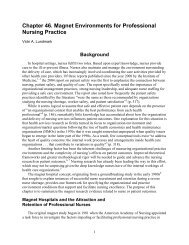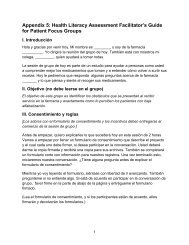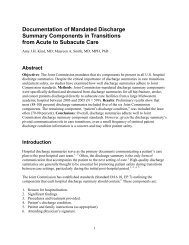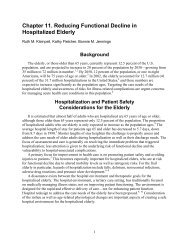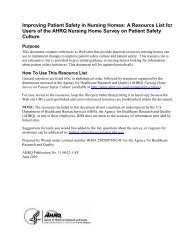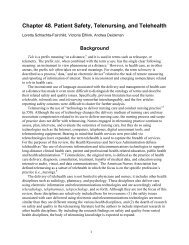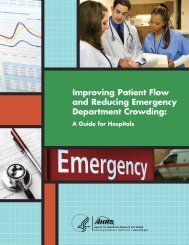Emergency Severity Index (ESI): A Triage Tool for Emergency ...
Emergency Severity Index (ESI): A Triage Tool for Emergency ...
Emergency Severity Index (ESI): A Triage Tool for Emergency ...
Create successful ePaper yourself
Turn your PDF publications into a flip-book with our unique Google optimized e-Paper software.
Chapter 2. Overview of the <strong>Emergency</strong><br />
<strong>Severity</strong> <strong>Index</strong><br />
The <strong>Emergency</strong> <strong>Severity</strong> <strong>Index</strong> (<strong>ESI</strong>) is a simple to<br />
use, five-level triage algorithm that categorizes<br />
emergency department patients by evaluating both<br />
patient acuity and resource needs. Initially, the<br />
triage nurse assesses only the acuity level. If a<br />
patient does not meet high acuity level criteria (<strong>ESI</strong><br />
level 1 or 2), the triage nurse then evaluates<br />
expected resource needs to help determine a triage<br />
level (<strong>ESI</strong> level 3, 4, or 5). The <strong>ESI</strong> is intended <strong>for</strong> use<br />
by nurses with triage experience or those who have<br />
attended a separate, comprehensive triage<br />
educational program.<br />
Inclusion of resource needs in the triage rating is a<br />
unique feature of the <strong>ESI</strong> in comparison with other<br />
triage systems. Acuity is determined by the stability<br />
of vital functions and the potential threat to life,<br />
limb, or organ. The triage nurse estimates resource<br />
needs based on previous experience with patients<br />
presenting with similar injuries or complaints.<br />
Resource needs are defined as the number of<br />
resources a patient is expected to consume in order<br />
<strong>for</strong> a disposition decision (discharge, admission, or<br />
transfer) to be reached. Once oriented to the<br />
algorithm, the triage nurse will be able to rapidly<br />
and accurately triage patients into one of five<br />
explicitly defined and mutually exclusive levels.<br />
This chapter presents a step-by-step description and<br />
overview of how to triage using the <strong>ESI</strong> algorithm.<br />
Subsequent chapters explain key concepts in more<br />
detail and provide numerous examples to clarify the<br />
finer points of <strong>ESI</strong>.<br />
Algorithms are frequently used in emergency care.<br />
Most emergency clinicians are familiar with the<br />
algorithms used in courses such as Basic Life<br />
Support, Advanced Cardiac Life Support, and the<br />
Trauma Nursing Core Course. These courses present<br />
a step-by-step approach to clinical decision making<br />
that the clinician is able to internalize with practice.<br />
The <strong>ESI</strong> algorithm follows the same principles.<br />
Each step of the algorithm guides the user toward<br />
the appropriate questions to ask or the type of<br />
in<strong>for</strong>mation to gather. Based on the data or answers<br />
obtained, a decision is made and the user is directed<br />
to the next step and ultimately to the determination<br />
of a triage level.<br />
A conceptual overview of the <strong>ESI</strong> algorithm is<br />
presented in Figure 2-1 to illustrate the major <strong>ESI</strong><br />
decision points. The <strong>ESI</strong> algorithm itself is shown in<br />
7<br />
Figure 2-1a. The algorithm uses four decision points<br />
(A, B, C, and D) to sort patients into one of the five<br />
triage levels. <strong>Triage</strong> with the <strong>ESI</strong> algorithm requires<br />
an experienced ED nurse, who starts at the top of<br />
the algorithm. With practice, the triage nurse will be<br />
able to rapidly move from one <strong>ESI</strong> decision point to<br />
the next.<br />
Figure 2-1. <strong>Emergency</strong> <strong>Severity</strong> <strong>Index</strong> Conceptual<br />
Algorithm, v. 4<br />
A yes<br />
patient dying? 1<br />
shouldn’t wait?<br />
C<br />
how many resources?<br />
none one many<br />
5 4<br />
no<br />
no<br />
D<br />
consider<br />
vital signs<br />
The four decision points depicted in the <strong>ESI</strong><br />
algorithm are critical to accurate and reliable<br />
application of <strong>ESI</strong>. The figure shows the four<br />
decision points reduced to four key questions:<br />
A. Does this patient require immediate life-saving<br />
intervention?<br />
B. Is this a patient who shouldn't wait?<br />
C. How many resources will this patient need?<br />
D. What are the patient's vital signs?<br />
3<br />
no<br />
yes<br />
©<strong>ESI</strong> <strong>Triage</strong> Research Team, 2004. Reproduced with<br />
permission.<br />
B<br />
2







